The land’s leanness was harsh on the eyes. Prairieland, dry and white, sprawled before us on an endless pin-straight road. Rusted cattle fencing followed us as we sped along — tumbleweeds leapt and waltzed in wild dry winds that whistled long and hungry. The vegetation all knelt eastward, warped sideways by a solitary life of endless wind.
Mesmerizing though it was, I had to take care not to doze along the road, for at just the moment I might’ve relegated myself to the apparent endlessness of that long, straight road — a sudden shift woke me from my stupor. A phalanx of bony, dessicated shrubs all formed in the distance like an army of bushy dwarves — and the road turned sharp and sudden. This was the rim of a vast and unseen canyon along a river whose name I did not yet know. And like a plane landing, the automobile descended down its switchbacked walls; each arm of the spidery road yielding another hundred-foot drop until, after many such drops, I saw the riverwater roiling below the white concrete bridge, and the ascent back up the other side began.
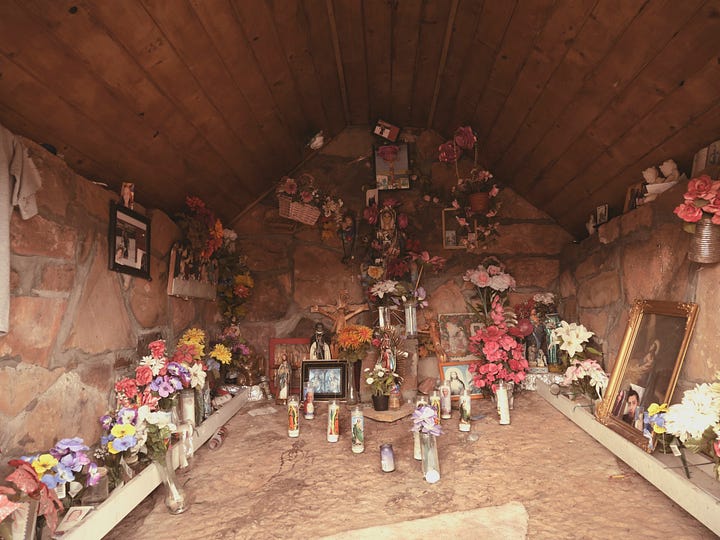
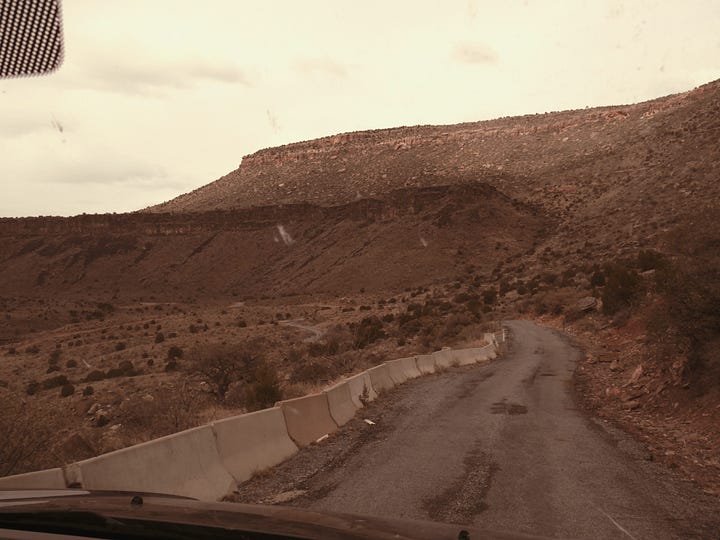
We are in ancient country; a place where the compass spins as it might in a pioneer’s hellish and parched fever dreams. To get one’s bearings here feels to be a futile endeavor — to travel here seems merely like an act of submission to the primordial plain; an exercise in featureless randomness and confusion.
Our driver is a stranger from the internet — a digital philosopher; a man enjoying the humble fruits of early half-retirement in a far-flung ghost town. He drives the schoolbus part-time; slaughters rams and forges knives, and his name is Adam. His sons are ranch-hands who all seem well-mannered and well-read. The wind has warped the soffits of his trailer roof, shaping them into a sort of metal ‘tongue’ to lap up the endless gusts flying off the plain, and the homes around his are almost all abandoned and decaying. The gate to a long-gone garden of thorns clanks open in the wind, then shuts again; opening and shutting autonomously, for no one.
We’d met the man earlier in the town with the train station and the big motel — the tired little city where the rag-top Chevy “low-riders” sat cold with flat tires in front of neon pawn shops with bars bolted onto the windows. Adobe barber shops with buffalo painted on them; gas stations selling cigarettes to kerchief-clad Hispanics who leered at us — and they leered because we were strangers. Ambling across the plaza, up to Our Lady of Sorrows Catholic Church, we got to know our new friend in the dry and sandy cemetery where old settlers slept below us — and the despondent eyes of the Virgin Mary followed us in the shellacky shine of a sunny wintertime morning.
“I actually think I know exactly what we could do…”
The man was musing aloud, holding his flip-phone in his hand and dialing his wife. I’d come here to interview him, or so I’d thought — what I knew of him from his writings online led me to think he’d have a great many fascinating things to say about New Mexico. He’d been living there for nearly a decade, after all.
Instead, he had another idea.
Unexpectedly, we blazed eastward in his car on a completely impromptu excursion into some of the most unpopulated land in the United States — blustering across the endless desolation with a stranger from the internet.
The old woman sat upright in a button-down blouse in her trailer in the silent village. Outside, adobe sheds and frost-covered cacti — and a sign on the door that said “AVE MARIA.” Our friend thought we might like to speak with her, for she was nearly ninety years old.
“It used to rain,” she said, taking a long look out the window. Her eyes moved slowly, but her mind was sharp. Soon, she was listing off crops her father grew on their farm five miles out of town — beans, hay, squash, watermelons. “Everything was done the hard way. Everything.”
Her name was Tomasita, and she was born at the farm in 1936. Her father was born there, too — in 1889.
“He didn’t speak any English, no — none. He couldn’t drive a car neither. Never wanted one. We did everything with a horse-wagon. And when the electricity came to our road, he didn’t want no part in it, so we never had it.”
She told tales of hauling water from the hand-dug well, and of life with her eleven siblings in their three-room adobe house. Even the roof was made of mud, two feet thick — and during heavy, soaking rains, it would leak badly. One winter, her five-year-old brother ate a balloon and died on the way to the hospital in Clayton, eighty-eight miles away. If it hadn’t been snowing so hard, he might’ve lived.
These are not stories from the 1700’s; they are not distant histories remote from our time. For many, this was simply life in Eastern New Mexico — as recently as the 1960’s and 70’s.
Above her hung another picture of another brother. He stood tall in a sharp uniform, and the photo had a grainy, slightly-yellowed, old-timey look to it. “He was drafted, that one was,” she said, her voice trailing off. “He died in World War Two.”
We talked for an hour or more, and the time flew by — this woman was a window into one of the most profound and rapid changes in human history, and my wife and I relished the opportunity to hear her stories. But there were other elders to meet, and the time came for us to go. She smiled as we thanked her and stepped off her porch.
Driving to the next old woman’s house, Adam said something especially insightful:
“People like Tomasita, they lived the whole 20th century in a single lifetime. They went from living in conditions bordering on medieval as children — to using cars and telephones and running water all at once. They were the ‘bridge generation’ between the old world and the new.”
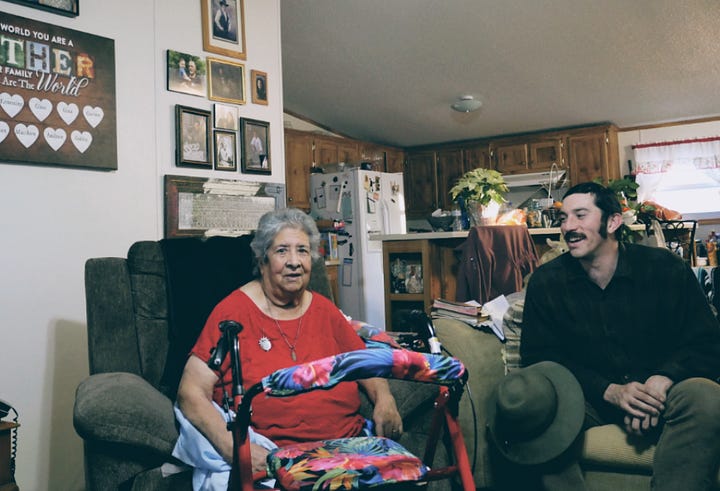
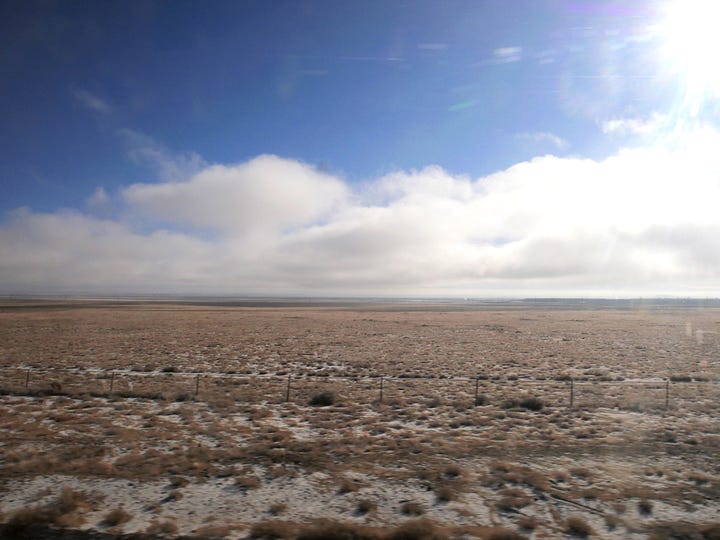
Of course, for those of us for whom the modern era is all we’ve ever known, it can be easy to have a romanticized vision of the past. It can even appear to be rational to reject the developments of the 20th century as abberant and misguided — it is often not hard for us to come to oppose them.
As the infamous Ted Kaczynski once wrote: “The industrial revolution and its consequences have been a disaster for the human race.” In many ways, he was not wrong to write that, and I find it hard to disagree with his assessment (even if I condemn his habit of sending letter-bombs over it). Yet among every elder we talked to — their gratitude for modern technology was patently obvious. Adam continued:
“If you’re looking for some kind of an affirmation of a Luddite idea, well — you’re just not gonna find it in these people. To them, if a thing is useful, they want to use it. There’s no ideal, no critique. It’s a simpler mindset than most modern people can even understand.”
All through New Mexico, this idea was clearly on display: New Mexican “low-rider” culture, for example, reads as a full-throated celebration of the automobile — not as a consumerist idol but as a useful machine that has successfully closed the gaps between towns in an unimaginably huge land area. Where once the young “low-rider’s” own grandfather might have been relegated to stay cloistered in his isolated village, tied to his feeble horse — now, a young lad can drive all over the state as he pleases. His world has finally become as large as the land itself, and it is a beautiful triumph for him. There is nothing tentative or half-hearted here; no conflict between some distant ideal and a useful machine. The New Mexican does not appear to overthink these matters at all. He just drives; he enjoys it, celebrates it.
In a landscape as vast and desolate as this one — who could blame him?
The land beneath us spoke in aphorisms and long pauses. Flat — canyon — flat — village — flat — ranch gate — and so on. It’s people are the same. The Spanish spoken here is slower than in Mexico, and there is an almost aphoristic quality to peoples’ thinking and speech. A patina of medieval romance hangs over the villages — and their people are ‘peasants’ in the best way imaginable. Far-flung and sparsely populated, the extreme moods of the climate dominate life here. Abstract thought seems to be a luxury, or perhaps a purposeless diversion. A human soul may have no use for it here. The silence of a man’s mind instead abides in the sands of time; resting in the worn sandstone and hidden cypress — cattle gleam in the sun’s gilded beams like dusky jewels in a sea of beige.
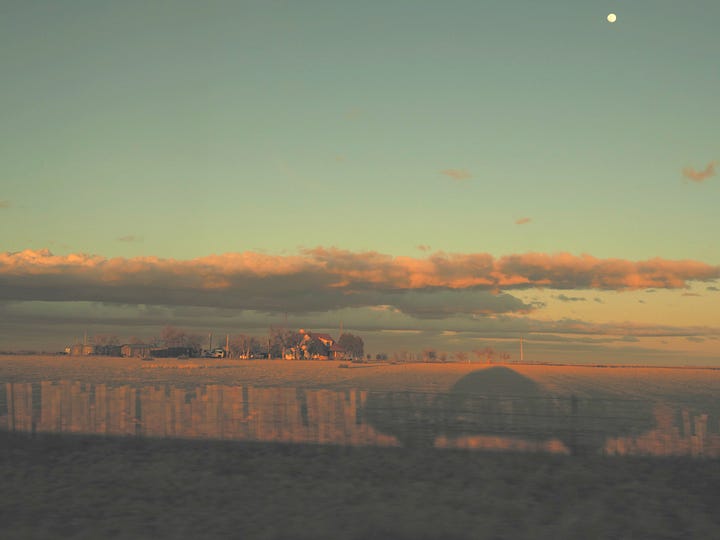
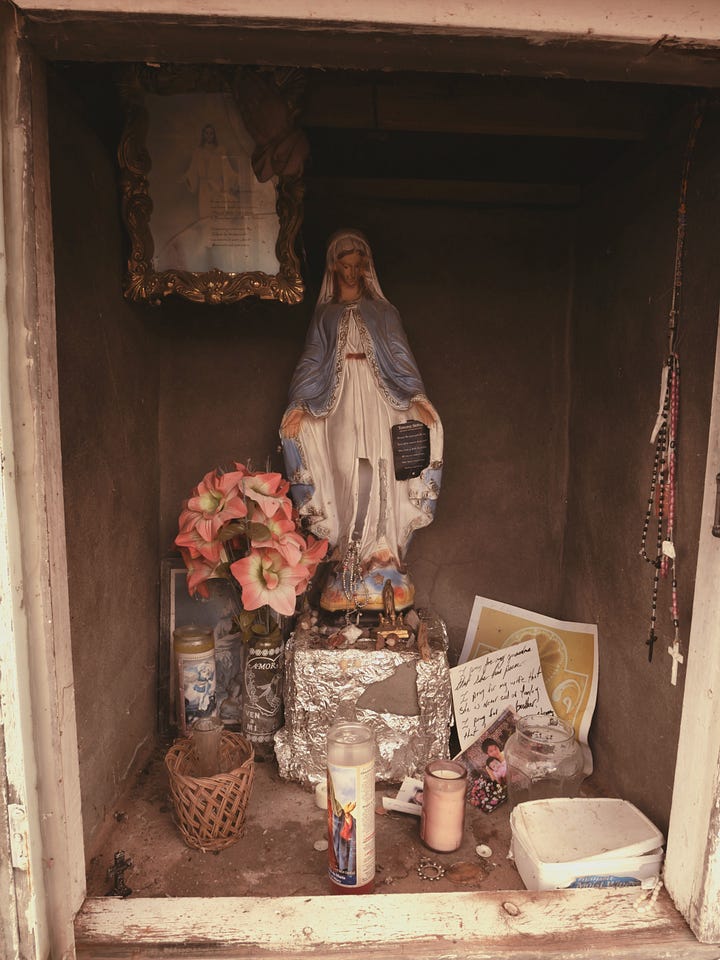
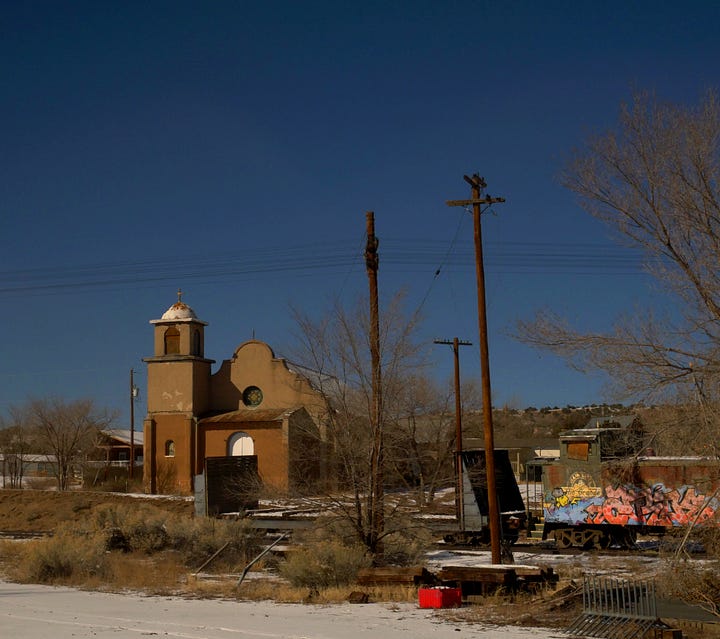
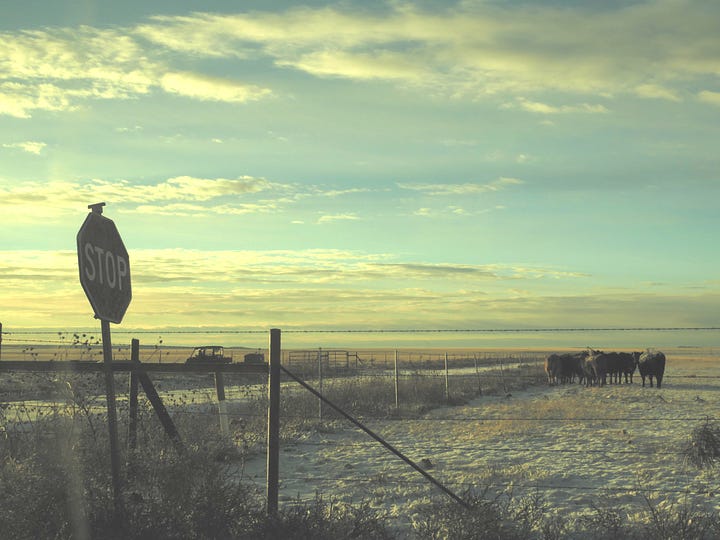
One wonders if the news that this place was now a part of “America” came with any kind of fanfare here at all. For when, in 1848, some government men far from here signed a treaty that made this land “American” then enjoyed a snort of scotch by their leathertop desks or at the mahogany bars of Washington — could anyone here know what it meant? Information has traveled so slowly here, and when received, has never surpassed the land itself in its gravity — and so perhaps it has entered the pores of this ancient culture less like a wave of wild news and more like a random breeze.
We must remember — New Mexicans are not “Mexican,” tempting though it may be to the outsider to imagine it could be true. Yes: New Mexico was a part of old Mexico for a time — about twenty-seven years — but it was brief, and in those days, the long arm of authority way down in Distrito Federal was so distant as to be an alien thing. Or, at least, in villages like these, it is fair to conjecture that it was paid very little heed. And quite the same with Washington, or even Santa Fe. To some of the villagers here, even the next village over might as well have been filled with foreigners.
When a distinct race of people with their own peculiar way fans out across a harsh realm of brushy plain and canyonland, each settling in for a period of four or even five centuries — this sort of thing is bound to occur.
And yet the somber look in homasita’s eyes as she told us of her brother confirmed that being American did mean something to her. Since the Civil War, New Mexicans from villages like hers have proudly served in every war this country has fought in. There can be no question about whether the people here are American or not — and even less of a question about whether they are Mexican or New Mexican.
Then, we arrived in another ghost town. Or, perhaps more accurately, it would have been a ghost town if it weren’t for Amelia. Born in 1940 in an extremely isolated canyon, she is a living antique from an era when the inhabitants of this place generally chose to take up their stead in deep canyons — out of the wind, flanked by clear-water springs, farming the small and rich alluvial flatlands by the water. It wasn’t until later that the plains themselves became much of a going concern — until the railroad and the homestead act. Prior to then, the canyons were the prime real estate, and Mrs. Amelia was native to one of them.
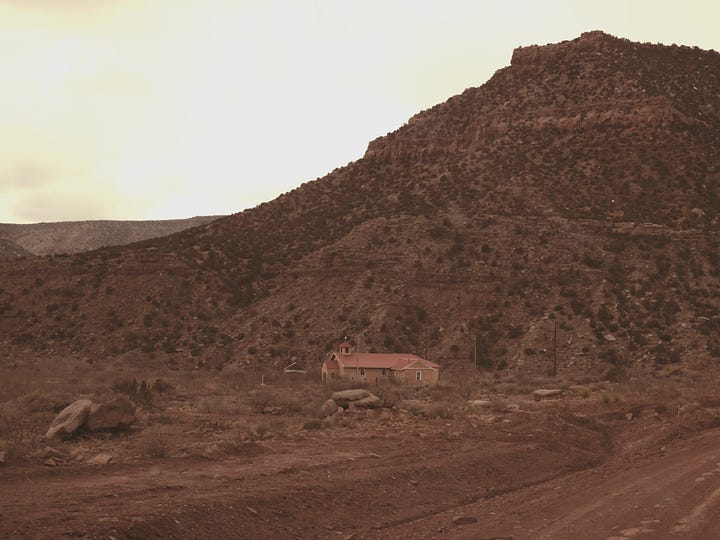
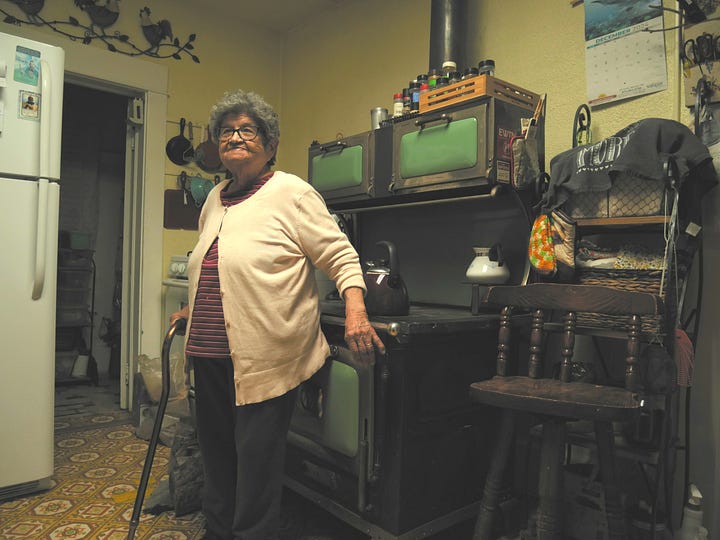
The word “insular” means, at least as far as the Latin root is concerned, “island,” or “islander.” But an oceanic island is far more accessible than her canyon hamlet ever was, for even the roughest waterborne transit would be preferable to the immense effort required to access her village. The topography is monstrous — confusing corridors of riverine stone, steep hillsides covered in ankle-twisting rock fissures and snakes; mysterious dry creeks and vernal pools. To visit there is to visit the depths of this rough country’s bones — it is to enter into a state of weird and luminous mystagogy; a prayerful and overwhelming initiation into a truly inaccessible, raw land.
“The Penitentes, they do hard, hard penance — very hard. They go into the Moradas, and there are no windows. Only candles.”
Adam spoke up to inform us that these “Penitentes” were a Catholic order that existed in a grey area so far as canonical licitude was concerned — a group of penitents who emerged in a climate where Priests were scarce and communication with the Vatican was basically non-existent. They built windowless “Moradas,” which were for men only — and there, they would enter a deep state of prayer, literally flagellating themselves, engaging in secretive and passionate religious rituals in lieu of being able to attend a regular Mass. Famously, a photograph exists of one Penitente group “crucifying” one of their members with ropes.
Once, when Amelia was five years old, she got lost on the river, deep in the canyon. At the time, there were no telephones, no electricity, few if any automobiles — and basically no formal emergency services of any kind. She told her story in shaky, halting speech, saying:
“My father was in the Morada, and I was walking with my uncle in the canyon, to my grandmother’s house, and we walked… but I told my uncle, ‘I’m gonna wait here for my dad.’ He said no — ‘we got to stay together.’ But we didn’t.”
“I went to sleep and they left me there. When I woke up, I still couldn't see nobody there. But me, I got scared, and I started running... Because I got lost, my dad asked Jesus to find me...”
She spoke of how the local Priest — who was infamous for using a small plane to fly out to these isolated communities to say Mass — did a flyover in his plane, flying low to search for her. But he could not find her.
“I just know that my grandfather... he was blind. He always carried a cane. And that man knew those canyons. He couldn't see, but he knew where he was going. And they told him what part of the canyon he was gonna look for me in. My dad said ‘Jesus, help us.’ He was gonna do whatever penance he was gonna do at the Morada... and after a long, long while, my Juanito, my grandpa, he was calling me and I was running scared, because I didn’t know who he was in the dark. He caught me with the cane... he went fast, he caught me with the cane. And he picked me up and you know he hugged me, and said, you know, ‘this is grandpa.’ And I was crying and crying. So all those Penitentes went — and they took me into the Morada, put me on the altar, and they all prayed...”



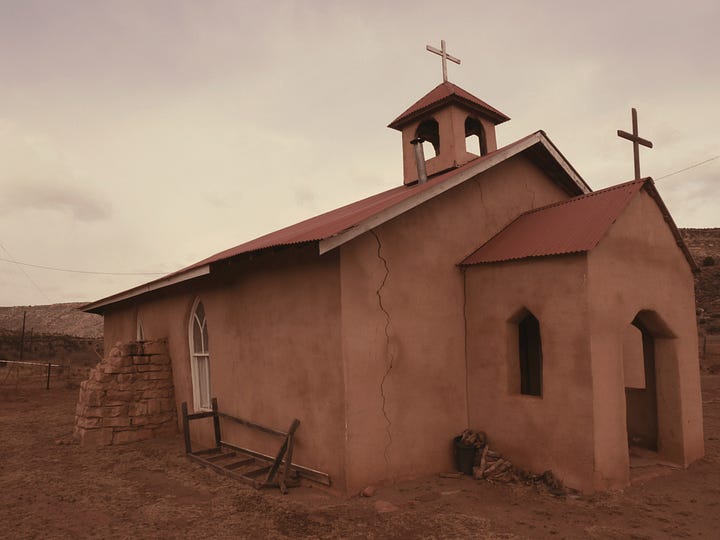
“Inside the Morada was dark; all candles, no windows. It was warm; they prayed the Rosary.. It was beautiful... I will always be thankful that my Juanito, being blind, was the one who found me...”
We were stunned at this incredible tale, and as she finished, the house was silent save for the crackling of her beloved wood stove — and an episode of Hee Haw that was playing quietly on her television. Outside, the same winds she’d known for her whole life lapped at the eaves of her roof, out on the plains in her lonesome, far-flung settlement.
A wave of gratitude crept up my spine as we all bid her goodnight. Amelia is old now; she will be gone soon — to rest with Jesus in heaven. She is one of the last living threads between the Old World and the New.
Soon, there will be no more like her left. I fear we may be lost without souls like hers.
Can human beings ever fade into the landscape so totally that they are as immovable as mountains and great canyons of stone? Can their color blend completely into the orange-red glimmer of centuries' worth of dawns upon the plains? Perhaps they can. Perhaps they are a truly timeless people; unbothered by what has changed — firm as the octillos stationed way up upon high-hummocked riverbanks. And in their contented tranquility and firmness, there is a certain kind of smile they smile; one which has no great pretension and makes no effort at putting on airs. Contentment exudes from their eyes — they have no sharp criticism for the modern world that has crept onto their desolate realm of plains and canyonlands; no harsh words for the flag that flies above the courthouse.
On our second day in the New Mexican east, we woke early for Mass at a small village Church. It was a modest, contemplative affair in a well-appointed and humble adobe building that was once a schoolhouse. And across the street, an old man lived — Tomasita’s brother Nick, born in 1942. He invited us in and gave us coffee. He looked shockingly young for an eighty-three-year-old; and he smiled at us with his big, cloudy blue eyes. We spoke of many of the same things we’d discussed with Tomasita, and as the coffee flowed, our conversation veered away from the past and toward the present.
I asked him: "Nick, if they made you the President of the United States, what would you do on your first day in office?"
He was very amused at the notion, and his old blue eyes beamed humbly as he pondered the question, chuckling. He smiled and said:
"I would tell everyone to be nice. That's probably what I would do!"
And it was then that I realized that though these people were swiftly ushered into the world of electric lights and diesel trucks, of grocery store bananas and drywall and television — they had not actually developed the intellectual sensibilities of ‘modern people.’ People like Nick and Amelia and Tomasita had not taken to the practice of constant criticism or nostalgia, nor of whining, nor, most of all, of the urge to have some kind of a grand, high-flying plan or vision of how things should be.
Though each was intelligent, driven, and hardworking — their intellects seemed not to be in the habit of imagining ideas and technologies to be like Lego blocks to build an ideal world with. Life, to them, seemed not to be a “choose your own adventure” game — indeed, it did not seem as if they viewed it as a “game” at all. They were simply living, organically, in a timeless, ancient, clean-hearted sort of way that is becoming increasingly foreign to more thoroughly modern minds.
Whatever neurosis may now be common to modern people, these people do not seem to have partaken in it at all.
For after all, the way things are in Eastern New Mexico — it has already been shown and determined. The elements of this place are indefatigable and constant; they do not bend to the will of men. Here, there is no sense in screaming into the wind. Far better to gently eye the cattle as they wander the plain; to wordlessly drift along the pin-straight white-dirt road with a few bales of hay to feed the animals. To greet one’s son at a birthday party with a warm and genuine embrace. Without flags, without revolutionary ideas — with only simple, ancient contentment.
From the view here, why would one ever yearn to "change the world?" Why would one ever descend into the madness of “overthinking?” For in this village, the world is already living well enough in her own way, and in a place like New Mexico — time has its own gravity and density, like a strong and clarifying tonic. Ancestors ride the current of time, hovering over the canyon walls and above the long-abandoned homesteads, and it is because of them that this mysterious landscape is not quite as lonely as an outsider might imagine at first blush.
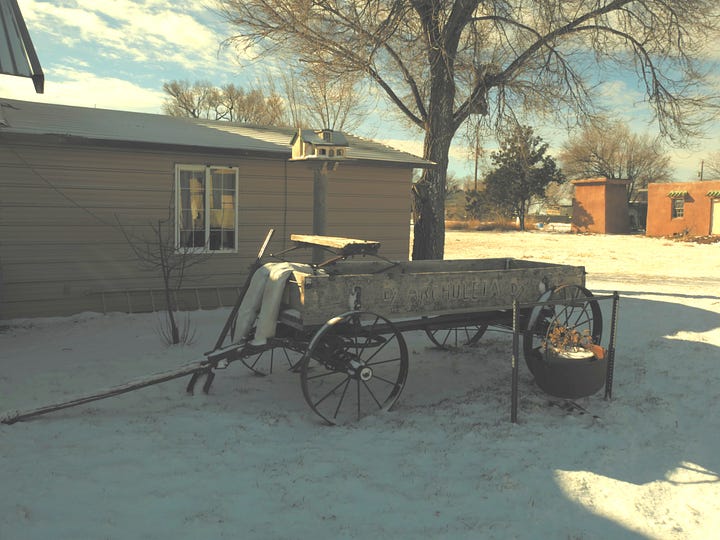
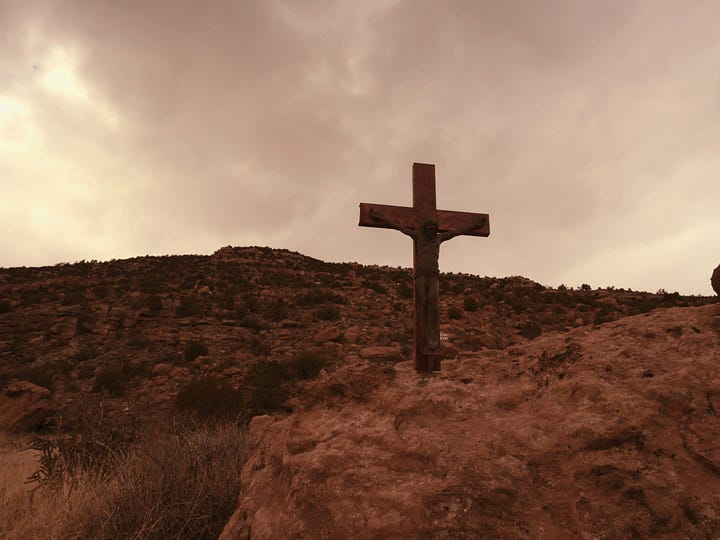
Even if it should all empty out to become another ghost town — there will still be ghosts. There will still be the ruins in the canyons, the roadside shrines; and always, a handful of rough old ranch-hands. The whole world could steam ever onward to madness or to glory, and some of it can and will trickle out into villages like these — but what will it change? The people themselves resist the nervous delirium of the times — the land commands it. The skies seem to bolster the men below them in their primeval fixity in time.
I might count this voyage into the New Mexican hinterlands among the most rich and valuable travel experiences of my life. This is a bold claim — and yet I think it is merited. For the stark differences between the world of the old and of the new have never been shown to me with such stunning clarity anywhere else. In fact, so clear a picture of the impossibly rapid changes of the 20th century did I receive here that I am reduced to a state of startled awe. Our modern mentality today seems so incongruously cavalier toward all that has changed in living memory. Perhaps we are all in a state of ‘shell shock’ in the deep recesses of our collective spirit. Perhaps so much of the disorder we know today stems from this breakage, as we have cut ourselves off from so many ancient lineages and ways of life, and we have done so at breakneck speed and with great gusto.
But for the New Mexicans — this breakage is not nearly so stark or painful; for they are children of a furiously resilient bloodline. The tranquil austerity of their land defies time itself. Change comes to them only as a strange and foreign melody — a tolerable thing incapable of altering the character of the land or the blood. Some portrait of old times endures, etched into every brick of the old homesteads and village homes; and a sense pervades that these people, who have been here for so many centuries — they will still be here for another five-hundred years or more, even if they are few. They will persist, softly and calmly; largely untrammeled and un-bothered by whatever the outside world may bring.
For the rest of us, perhaps things are different. It seems we are all on a “hero’s journey” that these most isolated New Mexicans may have no real need to embark on. To go from the raw and unfiltered life of ancient difficulty and elemental injustices; to sojourn out into the world of useful tools, ideal machines, complicated systems and utopian visions — and to wend back ‘round the bend again, back to some kind of a wordless yearning for the ways of old. Perhaps this is the mantle the rest of us must bear. As we sift through the ruins of our own forerunners, deftly navigating the tight crevasse between naive romanticism and a durable rekindling of our various ancient pasts — I suspect we may all benefit from studying those elders who so gracefully took the whole 20th century in a single gulp.
Perhaps we cannot go back; perhaps we would not want to. It may be that there is no “RETVRN.” But to assemble memories, to chronicle them — to sew them together into a thing we can all carry into our unknowable futures, to teach them to the children; this may be what is necessary as we run the long, shaky relay race of human history.
Let us gather up memories from those who lived them before they are all gone. It may be among the most important things we could ever do.



